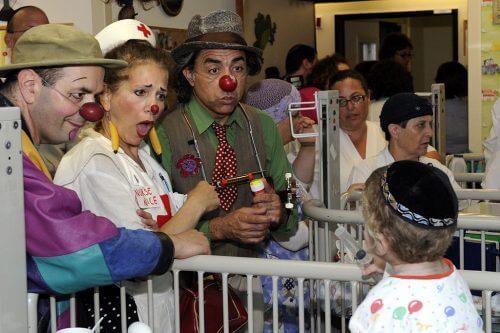We all like to laugh with friends and even alone, when we watch a funny series or read a funny book. What makes us laugh? How can laughter cure diseases? Why is laughter contagious? And is it really possible to "die laughing"?

Article: Human poem, Young Galileo
Charlie Chaplin was a well-known actor and creator who for years made many viewers around the world cry with laughter. Short Charlie is seen in the movie walking down the street, his pants are two sizes too big on him, his ridiculous mustache sticks out from under his pointed nose, and he whistles to himself and smiles. Suddenly the little man slips on a banana peel, and instead of worrying about getting hurt - the whole audience bursts into loud laughter. why?
There is a reason why certain situations make us laugh, and others make us cry or rage. You can learn to laugh and you can also learn to laugh spontaneous laughter. So what exactly is laughter, why do people laugh, and what things make us laugh?
The social function of laughter
Laughter is a physical and behavioral-social action that expresses joy and release, and sometimes it is contagious and not controlled. From a physical point of view, laughter is a reflex of muscle contraction and rapid expulsion of air. If we look inside a person's body when he laughs, it appears that the larynx, where the vocal cords are located, goes down and narrows the trachea, the diaphragm rises at an average rate of five contractions per second, and air is pushed up through the lungs while making a sound. The facial muscles and most of the body muscles also participate in the laughing process. That's why tears and blushing are also characteristic of a state of long and intense laughter.
Laughter is an inborn trait, and a baby can start laughing about a month after birth. When a baby starts to laugh, it creates initial communication with the parents, so laughter is a form of language. It is actually an international language that connects the members of the human species and allows us to communicate without words. There are many reasons why we laugh, and the main one is to activate certain areas of the brain while having a pleasant and light feeling of tension in the body.
Why do we usually laugh together? Laughter has a social function. Children who laugh together in kindergarten or in class, for example, consolidate socially and become friends. Apart from that, through laughter it is possible to convey different social messages, such as avoidance, love, threat and avoiding embarrassment. Laughter has a lot of power, both positively and negatively. We can see a person laughing and think of him as friendly and nice or full of confidence, as well as get a good impression of a person with a sense of humor. And there is also an evil laugh, which characterizes negative characters in plays and movies. The evil laugh increases the power and terror that the character conveys.

Caution, laughter is contagious
Have you ever seen someone laugh and immediately started laughing too? Or that a burst of laughter from someone at the end of the class caused the whole class to burst into laughter? Have you ever tried to stop laughing in a certain situation, but couldn't? It happens to everyone.
This is because laughter is contagious. Don't worry, it is not a disease, but it has been scientifically proven. In a study conducted at University College London, it became clear that when we hear the sound of laughter, our brain reacts automatically and causes the muscles to react which is expressed in a smile and laughter.
In the XNUMXs, a school in Tanzania was temporarily closed due to what they called a "laughter epidemic", after three female students infected two thirds of the students with hysterical laughter! The situation ended with a smile and no problems, but it only proved the claim: laughter is simply contagious.
The science of laughter
Many studies and books have been written about laughter and its characteristics. The best known of them is "Laughter" written by the Jewish-French philosopher Henri Bergson. This book accompanied many comedians, actors and creators in the construction of comedies, humorous plays, stand-up shows and more. Bergson treated laughter from a philosophical and social point of view and explained what the basic conditions are for creating a comic situation:
- "There is no comedy except in human things", that is, human qualities are the ones that make us laugh.
- "Laughter is a numbing of the emotion", meaning we need to neutralize the emotion and the heart in order to laugh.
- "Laughter is social", meaning that a person will not feel the comedy if he is alone. This is one of the reasons why comedy TV series sometimes add artificial audience laughter, so that as viewers at home we feel that someone is laughing with us.
Some of the main principles for creating a funny situation according to the book are: the principle of repetition (usually something that repeats three times with a slight change throughout the show), replacing natural things with artificial things (such as a character that suddenly appears with a purple doorman or a donkey's head), dealing with the physical instead of the spiritual (for example, A guy in love who serenades his lover, but refrains from peeing his pants), inversions (a man in a woman's clothes, a boy who educates an adult, a king who helps a servant), puns and exaggerations.
Laugh, it's healthy!
Today we already know that laughter is not only a matter of entertainment and fun, but it also has healing and health benefits. Many studies have found that laughter has a positive effect on body systems and improves the lives of patients. It's an available and effective solution, and it doesn't even cost money!
Laughter helps lower blood pressure, protect the heart, strengthen the immune system, strengthen the diaphragm muscles, gives a feeling of relaxation and improves mood. Some claim that laughter even slims down and burns calories, but to lose one kilogram with the help of laughter alone, you would have to laugh ten minutes every day for a whole year...
In 1955, the Indian family doctor Dr. Kataria researched the subject of laughter, and wrote: "Laughter is the best medicine." When he discovered the positive effects of laughter on health, he developed a unique therapeutic method called "laughter yoga".
This method helps people laugh by stimulating the laughter reflex physically, and not just by stimulating the brain through humor. As part of the method, one begins with exercises that release the laughter reflex and create a wave of rolling laughter among a group of people. People who practice the method regularly say that a person who stimulates the laughter reflex by proactive laughter over time becomes a lighter and happier person and has the courage to move forward and make changes in his life.
Dr. Kataria is the one who initiated the "International Laughter Day" in 1998, and 12 thousand people participated in laughter workshops around the world. Since then, International Laughter Day has been declared every year on the first Sunday of May and is a celebration of positivity, peace and brotherhood. And what happens in it? Thousands of people meet together to laugh, participate in laughter and humor yoga workshops, watch clown shows and puppet shows, dress up and be happy together.
What does a clown do in a hospital?

Another field that developed as a result of the research on laughter and humor as healing tools is medical clowning. Medical clowns use the healing power of humor to improve the mood, lives and functioning of patients in many hospitals and medical centers around the world.
In 1986, the "Medical Clowning Unit of the Big Apple Circus" was established in New York, and since then medical clowns have started working in hospitals in the big city. Later, medical clowns began to be employed in many countries of the world, some of them work voluntarily, out of concern and love for society.
They doubted the benefit that medical clowns brought, and many doctors saw medical clowning as a worthless and disturbing profession. But slowly they began to recognize the medical and mental importance of medical clowning, and the field expanded.
The medical clowns distract the patients from the pain, help them deal with difficult medical processes and relieve the stress they are under. They use humor, magic, stories, balloon shows and more.
One of the founders of the field of medical clowning is Dr. Hunter (Patch) Adams - a doctor, medical clown and social activist, who in 1972 founded the Gezontheit (which means "health") medical center. Comedian Robin Williams starred in the film based on his life story.
die laughing
Not everything ends well in the world of humor. It turns out that the phrase "dying laughing" is based on situations that probably happened in reality. Although it is rare and unusual, there have been cases where people have died of cardiac arrest or suffocation as a result of a prolonged and uncontrollable fit of laughter.
It is said that one of the people who died of laughter was the Greek philosopher Chrysippus Masuli, and that the reason for the fit of laughter that led to his death was this: Masuli asked an old woman to let the donkey drink wine, and watched the drunken donkey try to eat figs. This was probably in 207 BC.
It is claimed that the Burmese king Nanda Bayan also died of laughter in 1599, when he heard that Venice was a free country without a king; In 1989, an ear doctor from Denmark died of laughter while watching the comedy film "A Fish Named Wanda". His pulse was so fast with the laughter that he went into cardiac arrest.
This situation is called "fatal laughter" in literature, and the idea that it is possible to die laughing captured the imagination of many creators in the culture and became a part of fantasy books and imaginative literature. For example, in the book "Mary Poppins", one of the characters dies of laughter following a joke told to her by the father of the children who are the heroes of the book; In the book "Life, the Universe and Everything Else" by Douglas Adams, the character of Frack died of laughter, after an amusing detail of the hero's life was revealed to her; In the television series "The Flying Circus" of the Monty Python group, a man invented a joke that makes all its listeners laugh to death; And in the movie "Who Framed Roger Rabbit", Roger and Detective Eddie make fun of the weasels that come to attack them, until they die of laughter.
The article was published in Young Galileo - the monthly for curious children. For a gift digital sheet Click

One response
Who wrote this excellent article?
How can I get him/her?